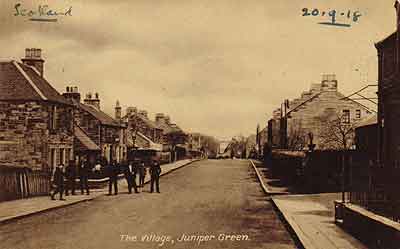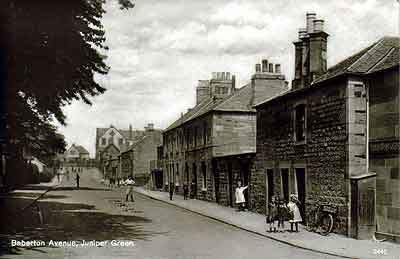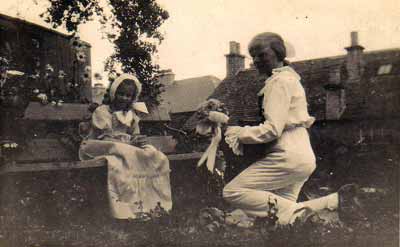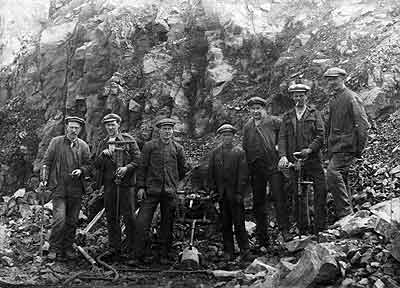Memories of Juniper Green
Reminiscence with Evelyn Andrews, Jean Brown, June Hannah, Cathy Stuart and Tommy Tweedie...
...in a group discussion with Christine McBean and Liz Beevers on November 13th 2006 at JG Village Hall. Also in attendance was Christine's daughter-in-law Marieke McBean who is preparing an article about Juniper Green 300 for publication.
Biographical details
Tommy was born in Juniper Green.
Cathy Stuart came to the village in 1955 but had spent summers with her aunt who owned and ran the newsagents at 579-585 Lanark Road. They also sold ice cream and had billiard tables in the back. Her uncle's mother had built those houses. Cathy and Dougie Stuart took over the shop in 1960/1 and a further reminiscence about the shop can be found elsewhere on this website.
Evelyn (nee Smart.) Her father and grandparents lived in Juniper Green. Her father was the postman with a story that appears elsewhere on this website.
For June and Jean see a separate reminiscence story on this website.
The ins and outs of Belmont road
Helen Bank, number 55, was rented from the blacksmith, Mr Anderson. The Anderson family lived in the big house next to St Margaret's Court. One of them was the village blacksmith (at 2 Juniper Avenue) but the family also had the farm at Fernieflat at Wester Hailes.
We used to stand and watch the blacksmith shoe the horses. He was still there at the beginning of the War and some time after that.
The houses over the wall from Helen Bank were called Annfield bordering the garage now. Walkerfield (the big house at the end of Juniper Grove) was a home for unmarried mothers at one stage. Some of them met partners from the village and stayed here. That might be as long ago as the First World War.
Toys and games
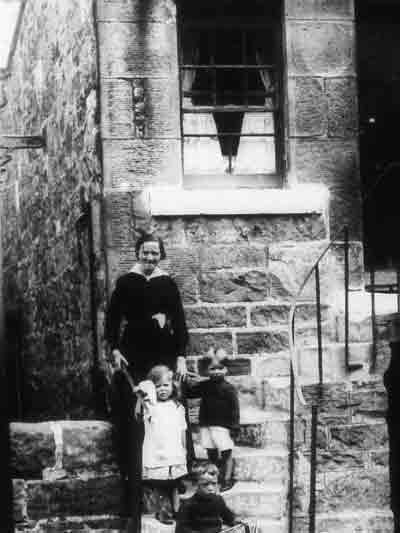
The children of Juniper Green would play at the back of houses like this one showing an outside stair in Baberton Avenue
Evelyn: The block behind Scott's the grocers (I mean where the hairdresser's is today at the corner of Baberton Avenue and Lanark Road, 540 Lanark road) used to be where a friend of mine lived and we used to play around the back. It was really just an earthen yard and a row of coal cellars. We would mark out "a house" with a stick and use an old clothes horse with a curtain over it. You just used your imagination and had a lot of fun.
We were allowed to play in the street, in front of the house as long as we stayed near. Mainly peevers, tig and hide and seek. The boys would play kick the can, marbles and football.
We'd play different things because the girls were over the wall in the school playground. We didn't have mixed playgrounds! Girls would play marbles too. Diabolos: that was a great skill to do it properly.
Yo-yos as well. They would come in crazes. There were certain games at different times of the year when you would play these games.
We did skipping to keep warm.
Archibald bald bald
King of the Jews Jews Jews
bought his wife wife wife
a pair of shoes shoes shoes ... to be sung with gusto!
"Granny in the kitchen doing some stitchin'
In came the bogey man and granny ran out".
You ran in on a line and out on the other side. You had to chase "granny" out.
You were in the school for lessons!
I didn't have Net Fraser but I did have Nell. She was all right but very strict. You couldn't talk; you would be in trouble if you spoke to anybody. You were in the school for lessons! Miss Black was even stricter but very fair. She was a kind lady, too and explained things to you better than Nell Fraser did. She was a tall woman, lived around Marchmont because years later I was a nanny and I met her quite often when I was out.
Evelyn: In my dad's time the school went right on up until the leaving age but when we went through (in the forties) we had the chance of secondary school at Tynecastle or Boroughmuir. I would be eleven when I went to Tynecastle.
Knitting for the war effort
We had knitting too. Blankets and socks, turning the heel the lot. This was War work for us. The school collected them and they were sent from the school.
Tommy: Yes, we had to knit squares as well.
Part-time schooling in the war.
Tommy: At the beginning of the war the school was closed but people would give us a front room in different houses every day and a teacher would come around to us. We went to the Bryce's where the yard was (Juniper Place now). They gave us a room upstairs in their house and we sat on the chairs and floor. I don't think we went to school every day, they worked it out so that everybody got their lessons. It would be Mon/Wed/Fri one week and Tue/Thu the next.
I remember going around to the different houses when the school closed: there was Linton's shop, the cafe up above, Mrs Yates and Mrs Ramsay up Grove Place (15 Belmont road now). The school re-opened because so many of us came back from being evacuated.
Food rationing
You had mostly vegetables to eat. Not much meat. The gardens all had vegetables growing in them. The sweetie ration was one quarter of sweets per week.
My father wasn't much of a gardener but he got an allotment along by Foulis Crescent road end where he would grow vegetables. There were other allotments too near where Dr MacKay's wood is today.
Starting work
Evelyn: I went to Tynecastle until I was fourteen and then onto work in town in the Children's Shelter then into day nurseries. I hated school, I was the bane of my mother's life because she left school at 17 and she thought I should have stayed on. I had missed a year's schooling and I think that had a lot to do with why I felt as I did. I had always wanted to work with children. You left school one day and started work the next in those days.
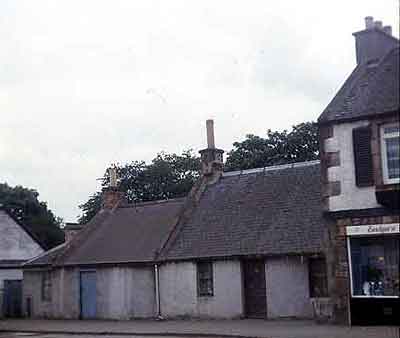
The building on Lanark Road close to where Tommy Tweedie worked as a painter and decorator
Tommy: When I left school I served my time and became a painter and decorator. I was apprentice to Donald Matheson in Lanark Road and I eventually took over the business. He was where the Chinese restaurant is today. I painted all around the place. I did five years as an apprentice reduced by one year because of the War. I learned by watching and being shown. I painted in some of the farms and the big houses. I worked down at Baberton House for Sir William and Lady White. He was head of the Royal Bank. His chauffeur would come along in the morning to pick him up for work. It was mainly in the Juniper Green, Currie, Balerno, Colinton area.
A walking funeral
It was usually a neighbour or Granny More who came along to help lay people out when they died. Mr Howit the joiner was the undertaker (Evelyn's dad's cousin) it cost about £20. You would walk the funeral from Juniper Green to Colinton and the coffin would be horse-drawn.
People would lower their blinds as the funeral passed and men would remove their hats.
Women wouldn't go to the funerals they would stay at home and prepare the tea. You would generally have sandwiches ...always in the house.
Doctors and nurses
There was Nurse Young from Colinton; she was a busy character. Nurse Beekie was the one before that. Nurse Young was little and Nurse Beekie was big and stout. Nurse Young would come on her bicycle to give my mother injections every month. She would come, go into the kitchen and there would be a packet of Sprats Ovals, dog biscuits, and she would empty them out and pick out the charcoal ones and put them in her pocket. She would then eat them! Charcoal is good for the digestion.
She would do injections for old people, babies and all that as everyone would have their babies at home in those days. We would be kept well away from all of that: we would be sent out to a neighbour. Dr Ross or Dr Sellar would come with the midwife. Dr Sellar was a big hearty doctor who didn't have a lot of sympathy but encouraged you to get well!
Teenagers
Christine: How did teenagers entertain themselves in those days?
We would come to the Village Hall just before the War for tap dancing: one year we had the Scouts' Fair in Walkerfield and we were tap dancing at it on a platform. We had daisies on our dresses.
We used to have weekly dances down here too. Mr Culbert had a lot to do with the hall in those days.
Tommy: As teenagers we would come down here (the Village Hall) for a game of billiards
Pageants: the highlight of the year.
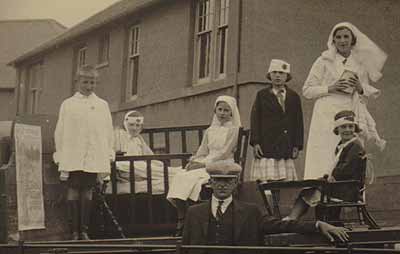
This float at the pageant has a picture of Tom Tweedie, Flora Ryan, Evelyn Andrews, Frances Gowans (nurse) and Jessie Erskine (sitting)
Evelyn: I was dressed as a nurse one year and a fairy another. We used to collect a tremendous amount of money for the infirmary. They stopped after the War.
Cathy: I would come here as a little girl for my holidays. I remember seeing one of the pageants in summertime in the school holidays.
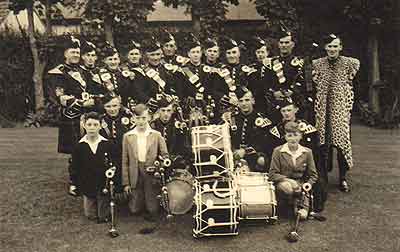
The Colinton and Currie Pipe Band founded in 1897 with Bill Blair and John Neil in light jackets
It started at the Village Hall, down Baberton Avenue, onto Belmont Road, up Juniper Avenue, onto Lanark Road up to the boundary, then right along Lanark Road to the crossroads, then back and up Foulis Crescent, Woodhall Terrace and back. Something like that. There would be people with cans following the lorries just collecting money. Folk would perform on the lorries: Bryce's lorries. Some would be horse and cart.
The Currie and Colinton Pipe Band would play at the pageants too. It was mainly men but Isabel Neil played in it but that would be later. Isabel played the pipes.
The mills
Cathy: The mill workers would use our shop a lot for papers, sweeties and cigarettes. So many worked there...
Evelyn: My aunt 'Tine worked in Kinleith all her life
Tommy: My mother was an overhauler...
June: My uncle Jim was the manager ...
Liz: I remember getting silvery card from the board mill to make crowns for the children at their parties and nativity plays.
One time there was a terrible mess in the village when something went wrong with Woodhall mill chimney. Everything was covered in soot, the cars got in a terrible state... even the kids in the school playground. That must have been in the early eighties.
When the quarry first closed the workers went down to Stow everyday. They were collected. Before that you would hear the explosions every afternoon. You'd see the dust first, hear the bang and then see all the birds rise up!
Characters
There was Matta Graham the old lady who lived in a cottage at the top of Juniper Avenue before the new houses were built. She wore a boy's school cap and carried a jug under her long white apron to go off to the Kinleith pub. Matta worked at Woodhall paper mill at one time. When one of the bosses' wives gave birth all the workers got a half sovereign and Martha said "Oh by golly, I wish she would have one every week".
Then there was Grace Scott who had the orchard up the park lane on the right. One boy got in and she caught him by the ear and ran him through all the nettles. She lived in the house on the opposite side to Leishman.
Jim Leishman
He lived on the right as you went up the park lane. The Leishmans had lived in Helen Cottage but eventually they took over the orchard.
He thought he could play the fiddle and used to give concerts.
He would walk into Fountainbridge every week to buy fish at the shop at the end of Dundee Street. He used to cycle in too because Demerera sugar was cheaper in town: if it was a penny cheaper he would find it. He built the houses around where he stayed. He worked in India for a long time too and that's where he made his money as a builder.
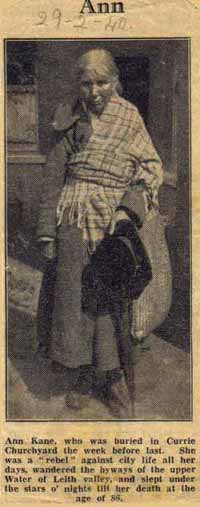
An article reporting the death of Annie Kane who could be seen in Juniper Green before the Second World War
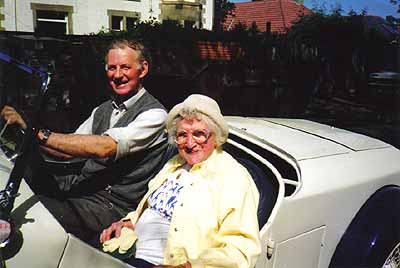
Miss Frances Turner of the builder's family who was one of many families that helped Annie Kane. Frances died in 1998 aged 102.
Annie Kane the gaunaboot wuman used to go to the Turners and they gave her a blanket for she slept in the Muir wood. Sometimes she'd get a bowl of soup. She had all her belongings with her.
Jackie Gibb
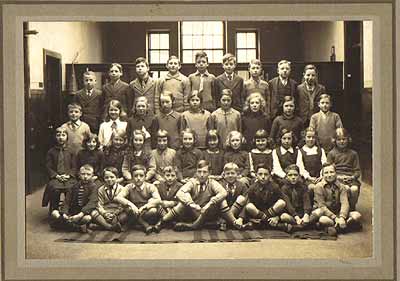
A class at Juniper Green school in 1931 with Jackie Gibb on the front row far left
There was Jackie of course. Everybody knew him. The church was packed for his funeral; that was in the late 1990s. Jackie would have been in his middle seventies. The minister (Mr Manson was the minister that day) was someone who knew JG because he looked at the congregation and said "Good morning Juniper Green". It was a lovely service with lots of Scottish music on the organ before it started. It was the War that upset him as he was in the army. Some say he was serving down around Hull and the doodlebugs came over and that upset Jackie. He was medically discharged.
He would come along to the church with his shopping bag and one day he had a big alarm clock with him. One day it went off in the middle of the service. Another time he came in with what he said was a pair of sun glasses but in fact they were swimming goggles. He kept them on all through the service. If you were in favour he would give you a sweetie. He would put one through Flora Ryan's letterbox. Jackie worked in the Kinleith mill but had unusual clocking in tactics. He would clock in and then disappear!

